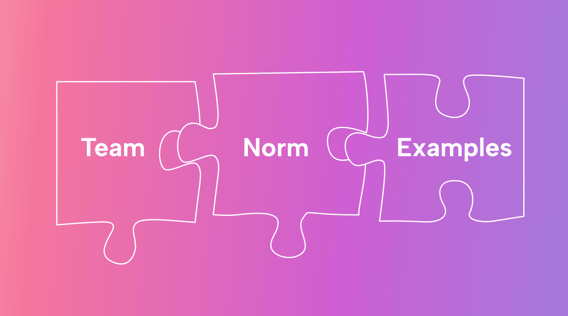Ever wondered what would happen if an organization decided to ditch team norms?
The answer is pure, unadulterated chaos!
Because let’s face it — every team needs team norms to help them understand how they’re expected to work and conduct themselves within their organization.
In this article, we’ll define team norms and share more than 40 examples for inspiration. We’ll also discuss some tips on how to create team norms for your workplace (and boosting team dynamics).
What are team norms?
According to psychologist Bruce Tuckman, every successful team goes through four stages — forming, storming, norming, and performing.
- In the forming stage, everything and everyone is new to the team. This often makes the team members unsure of what’s expected of them and how they’ll fit in.
- Next is the storming stage. Here, the team members push back against established boundaries, resulting in conflict or friction.
- When the norming stage kicks in, the individuals mentioned above start to accept the boundaries and the differences between them and their teammates.
- Finally, there’s the performing stage, where the team members are comfortable with one another, and team collaboration is hitting on all cylinders.
While these stages are inevitable, there are ways to help them go by quickly — or maybe even skip one or two.
How? Say hello to team norms.
Team norms are a set of agreements mentioned in the organization’s team charter on how team members will work, behave, and communicate. These rules allow the team to increase its collective performance through healthy debate and clarity of purposes and roles.
Examples of team norms would be the office’s dress code and guidelines on how to communicate and behave during meetings.
Why are team norms important?
Team norms make expected and acceptable behaviors abundantly clear for all team members.
This, in turn:
- Helps to prevent conflicts and misunderstandings.
- Allows self-policing.
- Sets and maintains the workplace culture.
- Helps teams adapt to new situations.
- Helps new team members understand expectations quickly (allowing for easy onboarding).
- Helps avoid workplace politics.
- Encourages team cohesion and accountability.
How do you create team norms?
Be sure to do the following when creating team norms:
Consider your team members’ unique needs
Each team is unique. So, determine why your team exists and what it aims to achieve to create team norms. This will help you focus on the types of expectations that will be most effective.
To help get you started, here are some example questions you can ask yourself to shape your team norms:
- Do my team members work in a client-facing environment?
- Does my team collaborate with folks from other departments in the organization regularly?
- Will there be many shared resources?
- Does my team have to deal with frequent high-pressure meetings, tight deadlines, or unpredictable workloads?
- Will there be virtual or remote meetings?
Make the norms specific
Make your team norms as specific as possible. If they aren’t, they can be very difficult to implement.
Here’s a simple example: Each team member is responsible for soliciting input from other members.
Sounds good? Not! Where is this expected to happen?
Adding the relevant location or event, like “during a meeting,” makes the norm specific.
Ask your team for their input
This is very important because your team is more likely to stick with the norms you set if they help you set them.
Here are some questions you can ask your employees to obtain their input:
- How should we handle conflicts or disagreements within our team?
- In your opinion, what makes a team meeting effective?
- What values do you think are important for our team to uphold?
- Are there any specific challenges or obstacles you foresee in our team achieving its goals?
- How do you prefer to communicate within the team?
 |
You can gather your team’s input in a meeting, a one-on-one session, or an anonymous survey.
Identify existing norms
Unspoken norms are unofficial rules that all teams know exist. They’re unofficial because they haven’t been officially or properly documented.
For example, your team might have an unspoken norm of arriving on time for meetings, signaling respect for everyone’s time and commitment.
So here’s what you want to do: With the help of your team, identify those existing team norms and use them as a starting point for creating new ones.
Consider virtual team norms
Is your team remote?
Virtual teams can have the toughest communication problems. As such, collaboration among them requires specific tools and systems.
Clarifying virtual team norms early on can be the difference between a high-performing team and an average one.
Here are some examples of virtual team norms:
- Each virtual teammate participates fully in each meeting they’re asked to attend.
- The team gives equal regard to remote and co-located employees.
Set general conduct norms
General conduct norms typically include rules regarding behavior. This means deciding how you want your team members to treat customers, supervisors, other employees, the media, etc.
Here’s what to keep in mind when creating general conduct norms:
- Your expectations for individual team members and the team as a whole.
- The best ways to encourage professional conduct within the team.
Describe team meeting expectations
Meetings can be either bad or good. Some are productive, especially when we stick to the plan and show up prepared. Others, however, seem to drag on forever, with little to show for them.
You want to set team norms that include guidelines on how to prepare for and behave during meetings. And don’t be afraid to get specific. Mention if you’ll send meeting notes through email, set up 10-minute follow-up sessions after each meeting, ask for opinions, and more.
Establish acceptable team behaviors during challenging situations
How would you like your team to behave when communicating with an important client?
What about when facing tight deadlines?
You can come up with similar questions to determine team norms when dealing with sticky situations.
Reflect on your experiences
Past experiences are your best teachers. Try to remember an old encounter with a specific team or a situation where your team was put on the spot. Then, analyze what worked in your favor and what you could’ve done better.
You can adapt each of these behaviors and strategies to your team.
45 team norm examples for inspiration
Here are some examples of team norms you can incorporate into your company:
Team communication norms
- We communicate transparently, without any hidden agendas.
- We don’t shoot the messenger.
- We communicate decisions quickly.
- We share all the information we have up front.
- We acknowledge when we lack answers, and we seek solutions collaboratively.
- We present problems in a way that promotes mutual discussion and resolution.
 |
Team meeting norms
- We circulate meeting agendas at least one business day before each meeting.
- We always come prepared for the topics and materials outlined in the meeting agenda.
- We discuss problems directly and find solutions instead of playing the blame game.
- We believe in speaking and listening — balanced participation.
- We’re always present in meetings and respect others’ time by limiting the use of electronics to emergencies only.
- We begin and end meetings on time.
- If we have something to say, we say it immediately instead of waiting.
Brainstorming norms
- All ideas are good ideas, and each contributor has value.
- Stay focused on the topic. We channel our energy into discussions that propel us forward.
- We build on the ideas of others instead of shutting them down.
- Judgment of ideas takes a backseat during brainstorming.
- We keep resource constraints in mind.
Conflict and disagreement norms
- Personal attacks are a no-no.
- We debate ideas in search of better solutions.
- We don’t throw each other under the bus.
- We raise issues with the appropriate people instead of whispering behind their backs.
- We don’t just say — we reason. We don’t say, “Corporate says so” — instead, we provide constructive feedback or information.
Project and work norms
- We work between 9 a.m. and 5 p.m. and not one minute before or after.
- We expect confidentiality around our business operations.
- We all own the implementation of team projects and products, not just our little pieces.
- We are always trying to improve how we conduct our work to achieve the team’s objectives.
- We love to experiment and try new things to see how they work.
- We share accountability for team performance.
- We adjust our priorities to address critical issues that affect our projects.
- We win and lose as a team.
- We respect and meet deadlines.
- We raise issues that affect team performance, even if they’re outside our usual turf.
 |
General conduct norms
- We always follow up on requests or questions.
- We arrive on time for work, meetings, and events.
- We acknowledge our mistakes.
- We don’t shy away from asking for assistance when necessary
- We accept constructive feedback.
- We do what it takes to meet team goals, even if it involves completing tasks below our level of expertise.
- We produce quality, consistent work.
- We stick to the playbook when it comes to our processes and procedures.
- We’re always polite to our peers, managers, team leaders, clients, and customers.
- We complete all assigned tasks on time.
- We accept responsibility for the outcome of any project we work on.
- We do our best to achieve our goals and do our part to help the team meet business objectives.
6 tips to keep in mind when establishing team norms
Here are some tips that’ll help you create efficient team norms:
1. Be realistic
Team norms must be realistic to be successful.
Why? Because if you set unreasonable expectations for your team members, they may feel unsafe or stressed. This will lead to one — and only one — result: reduced productivity.
2. Communicate clearly
It’s the manager’s and team leader’s duty to clearly communicate team norms specific to their departments. Only then can employees understand what’s expected of them to meet project or business expectations.
But that’s not it. A team leader also needs to ensure all that talk translates into a walk. They must enforce these norms consistently so that everyone is held accountable.
And guess what? These norms can be shared in a bunch of ways. You can say them out loud, write them down, or even use visual aids like posters or screensavers. Whatever you choose, the idea is to help communicate the norms clearly and effectively.
3. Be flexible and reevaluate the norms regularly
Every day is a new day with something to learn. Your team will have to adapt to team changes, collaborate with new clients, and more.
With such constant change, your team norms should also go through some updates.
Be flexible and open to reevaluating the norms periodically. Make adjustments as necessary to keep them relevant and effective.
For example, virtual teams may have limited face-to-face interactions, which challenges team rapport. Encourage frequent video conferences to help virtual team members feel welcomed and comfortable around their coworkers.
But how do you evaluate team norms?
By checking in regularly! You can do this in person, online, or via surveys that allow your team members to share their feedback, concerns, and suggestions. With their input, you can identify and resolve any misunderstandings or gaps in the team’s norms and values.
4. Ensure everyone is on board
This one is very important. You can’t establish effective team norms unless all team members agree to them. Disagreements can make it difficult for the rest of the team to stay on board.
 |
The secret sauce? Encouraging open discussion around set team norms!
5. Promote a culture of accountability
One magic word: Rewards!
You can let team members win gift cards or office goodies for upholding a certain number of norms.
If your team knows they can receive rewards for staying accountable, they’ll be more likely to follow your norms.
6. Adopt the right project management tool
How do you plan to track whether teams are adhering to your team norms?
A project management tool like Motion might just be your answer.
 |
With Motion, you can easily view tasks, their progress, assignees, related conversations, due dates, and more. All of these features will help you determine whether your teams are reliable, communicate clearly and politely, deal with strict due dates effectively, and more!
Team norms rule!
So, there you have it. Team norms aren’t just fancy guidelines — they’re the secret sauce that makes your daily operations run like butter. They also help ensure that everyone on your team knows what’s expected of them and how to conduct themselves.
As you keep an eye on whether your team is playing by the rules, why not make it easier with a tool like Motion? This project management tool facilitates transparency throughout a project’s lifecycle. You can track who is communicating well, how new hires are adjusting to the work environment, who is helping others, and more.
Sound like something you’d need? Sign up for Motion’s free trial today and witness the magic of streamlined collaboration!





